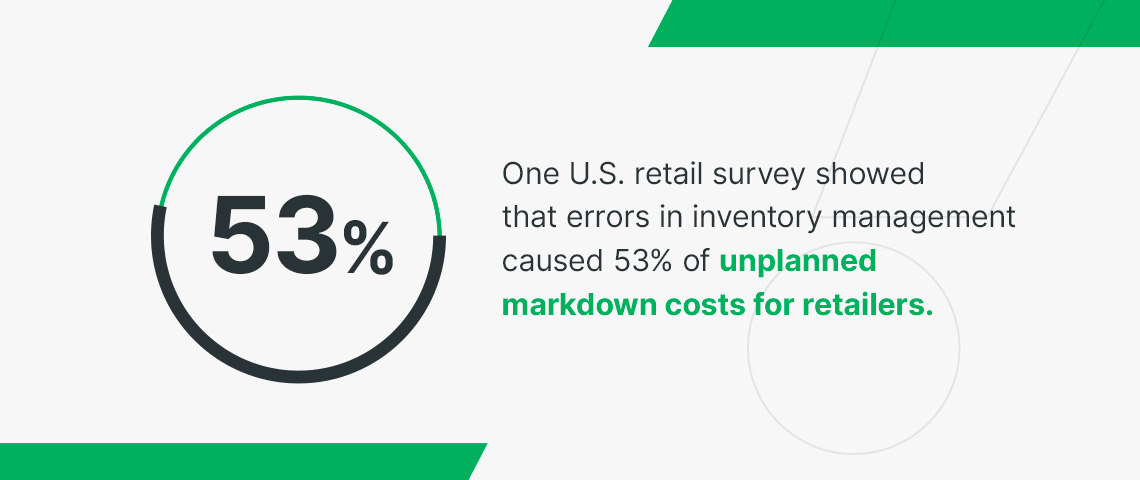Effective inventory management in retail is paramount to success. It entails buying, tracking, storing and selling stock, meeting customer demand and keeping costs down across the supply chain.
Through inventory management best practices, you can avoid running out of top-selling products or having a warehouse full of items you can’t sell.
Retail inventory management requires expert knowledge to understand buying trends, data and market analysis to set the correct prices and automation and software for optimal efficiency. The combination of these components is vital to a thriving retail business. Explore this retail inventory management overview and get tips for keeping shelves stocked and customers happy.
Types of Inventory
An essential part of retail store stock management is tracking goods as they move from the manufacturer to the distributor and warehouse and, finally, to retail chains. You must know the different methods for managing stock correctly.
- Raw materials: Also called feedstock, raw materials are the primary materials manufacturers use to produce finished products. Raw materials can include anything from wood, cotton, coal and crude oil to fruits, vegetables and biomasses. Some manufacturers produce the raw materials they need to develop finished goods, while others purchase them from a supplier.
- Work-in-progress: Stock takes that include WIP goods account for items that are still in the production stage.
- Finished products: Any goods that are ready to sell fall under “finished goods” in stock-taking. Some companies manufacture finished goods, while others purchase finished goods and sell them.
- Maintenance, repair and operations items: In inventory control, MRO items are goods that a manufacturer needs to produce items but that don’t directly form part of the finished product. Examples include tools like pliers, personal protective equipment, technology including desktops or even cleaning and office supplies.
- Packaging materials: This inventory includes all the materials used to package and protect products during shipping or storage.
7 Benefits of Inventory Management
Everyone across the supply chain can enjoy these seven benefits of accurate inventory management.
- Reduced costs: Having the correct amount of stock saves costs on several fronts — storage, transportation and handling fees and insurance. There is also less chance of having excess stock that won’t move or losing supply through theft, damage or a total drop in demand.
- Increased profits: When inventory matches demand, there is higher inventory turnover and increased profits.
- Time saved: Effective inventory management involves automating tasks to optimize processes and save time across the board.
- Improved accuracy: Proper inventory management lets you know how much product you have on hand and what you need to order.
- More significant insights: Spotting trends in retail and forecasting market trends becomes easier with consistent inventory control.
- Optimized business planning: A good grip on inventory management gives manufacturers the insight they need to scale their business, improve operations and customize strategies for selling more products.
- Improved customer service: A happy customer is everyone’s ultimate goal — from the manufacturer to the retail outlet. Every component of the supply chain profits from a satisfied buyer who can find the products they want, order them and receive them on time.
The Costs of Poor Inventory Management
Ineffective inventory management can be a costly mistake for any business. One U.S. retail survey showed that errors in inventory management caused 53% of unplanned markdown costs for retailers. That is a huge number, considering that the study also showed markdowns caused retailers to lose approximately $300 billion in revenues in previous years.
Improperly managing stock — including overstocking, understocking and carrying dead inventory — leads to various costs and consequences.
Overstocking typically happens because of misjudging demand, poor marketing or out-of-season purchases. When a retailer has a surplus of stock they can’t move, the overstock ties up cash. The surplus stock also loses money through storage costs and the risk of the product expiring or becoming obsolete, leading to further losses.
On the other hand, overstocking can lead to lost sales, missed order fulfillment and customer dissatisfaction. Either way, the costs of carrying dead stock can significantly impact businesses throughout the supply chain. Ordering enough inventory is the secret to reducing costs and increasing profits.
How to Improve Inventory Management
Follow these best practices and techniques for effective inventory management.
ABC Analysis — Prioritizing Products
ABC analysis is a way of arranging inventory in order of priority. The highest-priority products — A items — are those you frequently reorder, while C items are in less demand. ABC analysis is an effective way of organizing inventory and optimizing storage. You may also consider custom retail display solutions to build on the principle of ABC analysis and help promote and move stock according to your industry-specific product needs.
Establish KPIs
Tracking key performance indicators shows you how products or marketing methods perform over a set period. KPIs give business leaders the valuable insight they need to create inventory management and marketing strategies that pay off in the long term. Some KPIs you can focus on include carrying costs and inventory turnover.
Demand Planning
Consider seasonal trends, industry experts’ latest sales forecasts and historical data to plan for demand accordingly. Demand planning is one of the foundations of successful stock management. You can anticipate the correct amount of stock to meet demand, thus keeping costs down, maximizing profits and keeping customers satisfied.
Minimum Stock Threshold
Calculating the minimum stock threshold — the least amount of inventory needed at any given time — will help mitigate the risk of under- or overstocking. The minimum stock threshold will account for an unexpected rise in sales while reducing the risk of holding on to costly stock for too long. An easy formula for calculating the minimum stock threshold is (average daily sales of the product ÷ number of working days per month) x average product delivery time.
Custom Retail Displays for Optimizing Inventory From Creative Designs Now!
Inventory management in retail plays a vital role in having a successful supply chain. Businesses save on unnecessary costs, boost profits and keep customers happy when you have the appropriate inventory in stock.
Are you ready to implement effective inventory management strategies? Start your journey with Creative Displays Now! For almost 60 years, we have been industry leaders in custom, comprehensive display solutions and packaging options. Our team has expert knowledge in retail, including insights into the best techniques to improve retail inventory management by displaying products in a way that promotes them effectively. Contact us today to learn more about our custom retail display solutions or request an estimate for your unique display.





